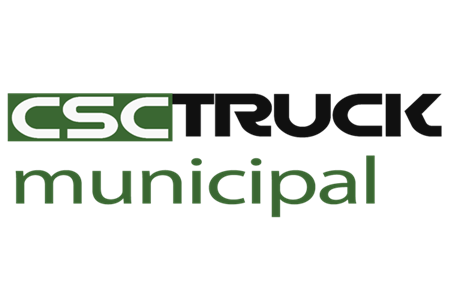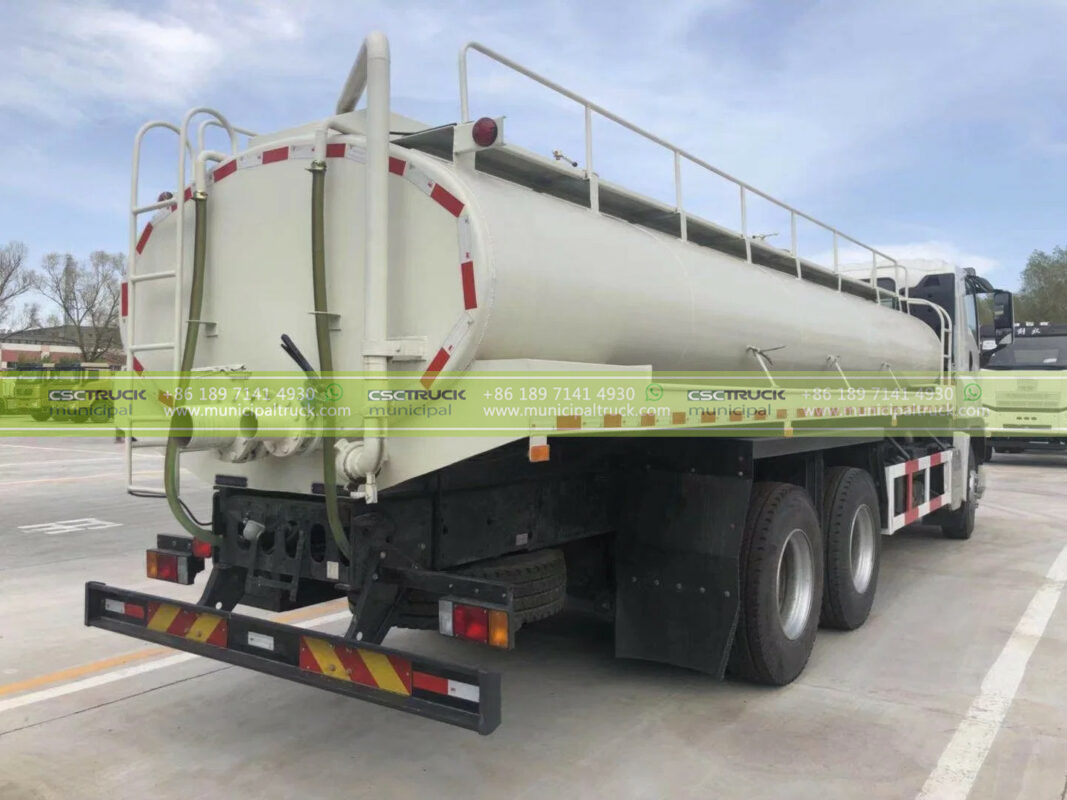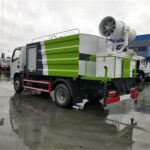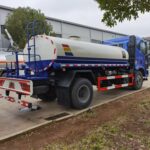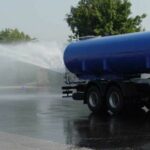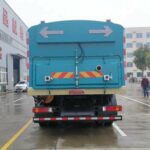The Static Past and the Adaptive Present
For decades, water sprinkler trucks operated on a fundamentally limited principle: on/off control with fixed flow rates. This binary approach treated every road condition, environmental factor, and operational requirement identically. Operators faced a stark choice – spray at full volume or not at all. This rigidity led to significant inefficiencies: excessive water consumption on lightly dusty roads, insufficient dust suppression on heavily trafficked or dry stretches, and an inability to dynamically respond to changing weather or traffic patterns mid-route. The advent of variable flow systems represents a paradigm shift, moving away from brute-force application towards intelligent fluid management. These sophisticated systems, integrating advanced hydraulics, electronic control modules, and real-time sensor feedback, allow for the precise modulation of water output – from a fine mist to a heavy curtain – instantaneously adapting to actual needs. This technological leap transforms the sprinkler truck from a simple sprayer into a responsive environmental management tool, defining the core of modern water sprinkler truck design by prioritizing precision over volume.
Decoding the Mechanics – The Engine of Adaptability
At the heart of this transformation lies a complex interplay of components engineered for dynamic control. Understanding the core mechanics reveals why variable flow systems are indispensable.
- Intelligent Pumping & Valving: Gone are simple centrifugal pumps running at constant speed. Modern systems employ variable displacement piston pumps or utilize sophisticated proportional control valves downstream of constant-speed pumps. These components can infinitely adjust their output or flow restriction based on electronic signals, enabling smooth transitions in flow rate without pump cycling or pressure spikes. This precise mechanical control is the physical enabler of flow variability.
- The Electronic Nerve Center: An Electronic Control Unit (ECU) acts as the system’s brain. Programmed with complex algorithms, it processes inputs from multiple sources. Operators input desired application rates or select pre-programmed modes (e.g., “light dust,” “heavy suppression,” “pre-wetting for sweeper”). Crucially, the ECU also interprets real-time data feeds.
- Sensor Integration – The Eyes and Ears: Modern trucks are equipped with an array of sensors providing critical real-time data. Ground speed sensors (often integrated with the vehicle’s telematics or GPS) tell the system how fast the truck is moving. Flow meters continuously measure actual water output. Pressure transducers monitor line pressure. Advanced systems may even incorporate dust sensors or ambient humidity/temperature sensors. This constant stream of data allows the ECU to make millisecond adjustments, ensuring the actual flow rate precisely matches the required flow rate for the current conditions.
The Tangible Triumphs – Efficiency, Effectiveness, and Environmental Stewardship
The implementation of variable flow systems delivers concrete, multifaceted benefits that justify their central role in contemporary design.
- Unprecedented Water Conservation: This is the most significant and immediate advantage. By applying only the water needed where and when it’s needed, variable flow systems routinely achieve water savings of 20-40% or more compared to fixed-flow predecessors. This is not merely an economic win (reducing refill frequency, lowering water costs); it’s a critical environmental imperative, especially in drought-prone regions or areas with limited water resources. Trucks can cover longer routes or suppress dust more effectively without increasing water consumption.
- Optimized Dust Suppression & Surface Conditioning: Fixed flow often meant under-application (leading to ineffective dust control and potential safety hazards) or over-application (causing mud, road degradation, and runoff). Variable flow enables precision application. On a damp, cool morning, a light mist suffices. On a hot, dry afternoon with heavy aggregate truck traffic, the system automatically ramps up volume to maintain effective dust palliation and optimal road surface moisture for binding fines. This ensures consistent, reliable performance regardless of fluctuating conditions.
- Enhanced Operational Flexibility & Control: Operators gain unprecedented command. Need to reduce spray near pedestrians or sensitive equipment? Instantly dial down the flow. Approaching a known high-dust zone? Pre-set the system to increase output automatically. Integrating with route optimization software allows for flow rates to be pre-programmed based on GIS data for different road segments. This level of control enhances safety, minimizes nuisance, and maximizes the truck’s utility across diverse municipal or industrial tasks.
Synergy in the Municipal Fleet – Beyond Standalone Sprinkling
The true power of variable flow technology is amplified when integrated into broader municipal operations, particularly working in concert with other specialized vehicles.
- Precision Partner for Sweeper Trucks: The effectiveness of a sweeper truck is heavily dependent on optimal surface moisture. Too dry, and dust is kicked up, reducing air quality and making collection inefficient. Too wet, and debris becomes slurry, clogging filters and reducing pickup efficiency. A water spray truck equipped with variable flow acts as the perfect precursor. It can apply the exact amount of moisture needed to bind dust and condition debris for optimal pickup by the sweeper following behind. The variable system allows this moisture level to be perfectly maintained even as the sweeper truck’s speed or the underlying surface conditions change, ensuring peak sweeper truck performance and dust control throughout the cleaning operation. This coordinated effort significantly boosts overall street cleanliness while minimizing total water used.
- Adaptive Support for Multi-Purpose Spraying: Modern water spray trucks often serve multiple functions beyond dust control: street flushing, vegetation watering (in parks or medians), or even light fire suppression support. Variable flow systems are essential for these diverse roles. Flushing a gutter requires a concentrated, higher-pressure stream, while watering delicate saplings needs a gentle, low-volume shower. The same truck can seamlessly switch between these tasks with optimal flow and pressure for each, maximizing fleet versatility and reducing the need for highly specialized single-function vehicles. This adaptability is a key efficiency driver for municipal fleets.
The Strategic Imperative for Municipal Operations
For municipal public works directors and fleet managers, investing in water spray trucks with advanced variable flow systems transcends a simple equipment upgrade; it represents a strategic commitment to operational excellence and responsible resource stewardship. The municipal truck fleet is a significant budgetary and environmental footprint. Integrating this technology delivers compelling advantages:
- Substantial Cost Reduction: The dramatic water savings directly translate to lower water procurement costs and reduced frequency of refill stops, saving both time and fuel. Less water hauled also means potential for smaller, more efficient truck chassis or increased payload capacity for other tasks. Reduced wear on pumps and valves due to smoother operation lowers long-term maintenance costs.
- Enhanced Service Delivery & Public Satisfaction: Consistent, effective dust control leads to cleaner air, improved road safety (better visibility), and less mud tracked onto residential properties or sidewalks. Precise application minimizes water overspray nuisance to pedestrians, cyclists, and parked vehicles. The ability to respond effectively to citizen complaints about specific dust hotspots is greatly enhanced. This directly improves the community’s perception of municipal services.
- Future-Proofing & Regulatory Compliance: As environmental regulations concerning water usage and particulate matter (PM10/PM2.5) emissions become increasingly stringent, variable flow systems provide the technological foundation for compliance. They offer the data logging and precise control necessary to demonstrate responsible water use and effective dust mitigation strategies. Furthermore, the adaptability of these systems positions municipalities to handle evolving challenges, such as more frequent drought conditions or expanding urban development, without requiring complete fleet overhauls. In essence, the variable flow system is no longer a luxury feature; it is the defining technological core that enables the modern municipal truck fleet to achieve higher performance, greater efficiency, and enhanced environmental responsibility in its vital role of maintaining community infrastructure and public health.
